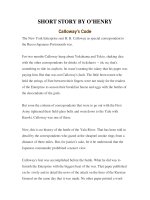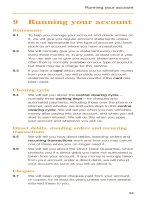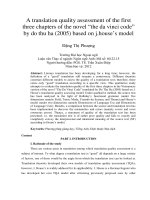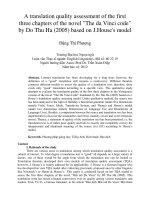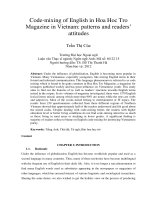IMDG code
Bạn đang xem bản rút gọn của tài liệu. Xem và tải ngay bản đầy đủ của tài liệu tại đây (21.36 MB, 537 trang )
Contents
Volume 2
Page
PART 1 -
GENERAL PROVISIONS, DEFINITIONS AND TRAINING
See Volume 1
PART 2 -
CLASSIFICATION
See Volume 1
PART 3 -
DANGEROUS GOODS LIST AND LIMITED QUANTITIES EXCEPTIONS
Chapter 3.1
General
3.1.1
Scope and general provisions .................................
3
3.1.2
Proper Shipping Names ......................................
4
3.1.3
Mixtures and solutions containing one dangerous substance ..........
5
3.1.4
Segregation groups .........................................
5
Chapter 3.2
Dangerous Goods List
3.2:1
Structure of the Dangerous Goods List ..........................
18
3.2.2
Abbreviations and symbols ...................................
20
Chapter 3.3
Chapter 3.4
Special provisions applicable to certain substances,
materials or articles
179
Limited quantities
3.4.1
General ..................................................
193
3.4.2
Packing ..................................................
193
3.4.3
Stowage .................................................
193
3.4.4
Segregation ..............................................
:
3.4.5 . Marking and labelling ........................................
193
3.4.6
Gocumentation ............................................
194
3.4.7
Exemptions ...............................................
194
3.4.8
Marine pollutants ...........................................
194
Chapter 3.5
PART 4 -
193
Transport schedules for class 7 - radioactive material
3.5.1
Transport schedules ........................................
195
3.5.2
Summary of approval and prior notification provisions for class 7 .......
253
PACKING AND TANK PROVISIONS
See Volume 1
PART 5 -
CONSIGNMENT PROCEDURES
See Volume 1
PART 6 -
CONSTRUCTION AND TESTING OF PACKAGINGS, INTERMEDIATE BULK
CONTAINERS (IBCs), LARGE PACKAGINGS, PORTABLE TANKS AND
ROAD TANK VEHICLES
See Volume 1
PART 7 -
PROVISIONS CONCERNING TRANSPORT OPERATIONS
See Volume 1
IMDG CODE (Amdt.
31-02)
iii
Chapter 3.1
General
3.1.1
Scope and general provisions
3.1.1.1
The Dangerous Goods List in chapter 3.2 lists many of the dangerous goods most commonly transported. The
list includes entries for specific chemical substances and articles and generic or "not otherwise specified"
entries. Since it is not practical to include a separate entry for every chemical substance or article of
commercial importance specifically by name, especially names for mixtures and solutions of various chemical
constituents and concentrations, the Dangerous Goods List also includes generic or "not otherwise specified"
names (e.g. EXTRACTS, FLAVOURING, LIQUID, UN 1197 or FLAMMABLE LIQUID, N.O.S., UN 1993). On tllis
basis, the Dangerous Goods List is intended to include an appropriate name or entry for any dangerous good
which may be transported.
3.1.1.2
Where a dangerous good is specifically listed by name in the Dangerous Goods List, it shall be transported in
accordance with the provisions in the List which are appropriate for that dangerous good. A generic or "not
otherwise specified" entry may be used to permit the transport of substances, materials or articles which do
not appear specifically by name in the Dangerous Goods List. Such a dangerous good may be transported
only after its dangerous properties have been determined. Dangerous goods shall be classified according to
the class definitions, tests and criteria. The name which most appropriately describes the dangerous goods
shall be used. Only when the specific name of the dangerous goods does not appear in the Dangerous Goods
List or the associated primary or subsidiary hazards assigned to it are not appropriate may a generic or "not
otherwise specified" name be used. The classification shall be made by the shipper/consignor or by the
appropriate competent authority where so specified in the Code. Once the class of the dangerous good has
been so established, all conditions for transport, as provided in this Code, shall be met. Any dangerous good
having or suspected of having explosive characteristics shall first be considered for inclusion in class 1. Some
collective entries may be of the generic or "not otherwise specified" type provided that the Code contains
provisions ensuring safety, both by excluding extremely dangerous goods from normal transport and by
covering all subsidiary, risks inherent in some goods.
3.1.1.3
Inherent instability in ~oods may take different dangerous forms, for example explosion, polymerization with
intense evolution of heat or emission of flammable, toxic, corrosive or asphyxiant gases. The Dangerous
Goods List indicates that certain dangerous goods, or dangerous goods in a specific form, concentration or
state, are prohibited for transport by sea. This means that the goods specified are not suitable for transport by
sea under normal conditions of transport. This does not mean that such goods may not be transported under
any circumstances. For most goods, such inherent instability can be controlled by suitable packaging, dilution,
stabilization, addition of an inhibitor, temperature control or other measures.
3.1.1.4
Where precautionary measures are laid down in the Dangerous Goods List in respect of a given dangerous
good (such as that it shall be "stabilized" or "with x% water or phlegmatizer"), such dangerous good may not
normally be transported when these measures have not been taken, ur1less the item in question is listed
elsewhere (such as class 1) without any indication of, or with different, precautionary measures.
3.1.1.5
Certain substances, by the nature of their chemical composition, tend to polymerize or otherwise react in a
dangerous manner under certain conditions of temperature or in contact with a catalyst. Mitigation of this
tendency can be carried out either by requiring special transport conditions or by adding adequate amounts of
chemical inhibitors or stabilizers to the product. These products shall be sufficiently stabilized to prevent any
dangerous reaction during the intended voyage. If this cannot be ensured, the transport of such products is
prohibited.
3.1.1.6
Where the contents of a portable tank is to be transported heated, the transport temperature is to be
maintained during the intended voyage unless it is established that crystallization or solidification on cooling
would not result in instability, which can occur with some stabilized or inhibited products.
Part 3 - Dangerous Goods List and limited quantities exceptions
3.1.2
Proper Shipping Names
Note 1: The Proper Shipping Names of the dangerous goods are those listed in chapter 3.2, Dangerous Goods
List. Synonyms, secondary names, initials, abbreviations of names, etc. have been included in the Index to
facilitate the search for the Proper Shipping Name (see Part 5, Consignment Procedures). Where, in this Code,
the term "Proper Shipping Name" is used, it is the "correct technical name" required by regulation 4 of Annex III
of MARPOL 73/78, as amended.
Note 2: For Proper Shipping Names to be used for dangerous goods shipped as limited quantities, see 3.4.5
and 3.4.6.
Note 3: For Proper Shipping Names to be used for transport of samples, see 2.0.4. For Proper Shipping
Names to be used for transport of wastes, see 5.4.1.4.3.3.
3.1.2.1
The Proper Shipping Name is that portion of the entry most accurately describing the goods in the Dangerous
Goods List, which is shown in upper-case characters (plus any numbers, Greek letters, 'see', 'tert' , and the
letters m, n, 0, p, which form an integral part of the name). An alternative Proper Shipping Name may be shown
in brackets following the main Proper Shipping Name (such as ETHANOL (ETHYL ALCOHOL)). Portions of an
entry appearing in lower case need not be considered as part of the Proper Shipping Name but may be used.
3.1.2.2
When conjunctions such as "and" or "or" are in lower case or when segments of the name are punctuated by
commas, the entire name of the entry need not necessarily be shown in the transport document or package
markings. This is the case particularly when a combination of several distinct entries are listed under a single
UN Number. Examples illustrating the selection of the Proper Shipping Name for such entries are:
.1
UN 1057 LIGHTERS or LIGHTER REFILLS - The Proper Shipping Name is the most appropriate of the
following possible combinations:
LIGHTERS
LIGHTER REFILLS;
.2
UN 2583 ALKYLSULPHONIC or ARYLSULPHONIC ACIDS, SOLID with more than 5% free sulphuric acid
- The Proper Shipping Name is the most appropriate of the following:
ALKYLSULPHONIC ACIDS, SOLID
ARYLSULPHONIC ACIDS, SOLID;
.3
UN 3207 ORGANOMETALLIC COMPOUND or COMPOUND SOLUTION or COMPOUND DISPERSION,
WATER-REACTIVE, FLAMMABLE, N.O.S. - The Proper Shipping Name is the most appropriate of the
following possible combinations:
ORGANOMETALLIC COMPOUND, WATER-REACTIVE, FLAMMABLE, N.O.S.
ORGANOMETALLIC COMPOUND SOLUTION, WATER-REACTIVE, FLAMMABLE, N.O.S.
ORGANOMETALLIC COMPOUND DISPERSION, WATER-REACTIVE, FLAMMABLE, N.O.S.
each supplemented with the technical name of the goods (see 3.1.2.8.1).
3.1.2.3
Proper Shipping Names may be used in the singular or plural as appropriate. In addition, when qualifying
words are used as part of the Proper Shipping Name, their sequence on documentation or packages is
optional. Commercial or military names for goods of class 1, which contain the Proper Shipping Name
supplemented by additional text, may be used.
3.1.2.4
Where it is not already included, the qualifying word "LIQUID" or "SOLID", as appropriate, shall be added to
the Proper Shipping Name of a substance which, due to the differing physical states of the various isomers of
the substance, could be either liquid or solid (see 1.2.1 for definitions of liquids and solids).
3.1.2.5
Where it is not already included, the qualifying word "MOL TEN" shall be added to the Proper Shipping Name
when a substance which is solid in accordance with the definition in 1.2.1 is offered for transport in the molten
state (such as ALKYLPHENOL, SOLID, N.O.S., MOLTEN). For elevated temperature substances, see
5.4.1.4.3.4.
3.1.2.6
Except for self-reactive substances and organic peroxides and unless it is already included in capital letters in
the name indicated in the Dangerous Goods List, the word STABILIZED shall be added as part of the Proper
Shipping Name of the substance which without stabilization would be forbidden from transport in accordance
with 1.1.4 due to it being liable to dangerously react under conditions normally encountered in transport (such
as TOXIC LIQUID, ORGANIC, N.O.S., STABILIZED). When temperature control is used to stabilize such
substances to prevent the development of any dangerous excess pressure, then:
3.1.2.7
4
.1
For liquids: where the SADT is less than 50°C, the provisions of 7.7.5 shall apply;
.2
For gases: the conditions of transport shall be approved by the competent authority .
Hydrates may be included under the Proper Shipping Name for the anhydrous substance.
IMDG CODE (Arndt. 31-02)
Chapter
3.1 - General
3.1.2.8
Generic or "not otherwise specified" (N.D.S.) entries
3.1.2.8.1
Generic and "not otherwise specified" Proper Shipping Names that are assigned to special provision 274 in
column 6 of the Dangerous Goods List shall be supplemented with their technical or chemical group names
unless a national law or international convention prohibits its disclosure if it is a controlled substance. For
explosives of class 1, the dangerous goods description may be supplemented by additional descriptive text to
indicate commercial or military names. Technical and chemical group names shall be entered in brackets
immediately following the Proper Shipping Name. An appropriate modifier, such as "contains" or "containing"
or other qualifying words such as "mixture", "solution", etc., and the percentage of the technical constituent
may also be used. For example: "UN 1993 Flammable liquid, n.o.s. (contains xylene and benzene), 3, PG II".
3.1.2.8.1.1
The technical name shall be a recognized chemical or other name currently used in scientific and technical
handbooks, journals and texts. Trade names shall not be used for this purpose. In the case of pesticides, only
ISO common name(s), other name(s) in the WHO Recommended Classification or Pesticides by Hazard and
Guidelines to Classification, or the name(s) of the active substance(s) may be used.
3.1.2.8.1.2
When a mixture of dangerous goods is described by one of the "N.O.S" or "generic" entries to which special
provision 274 has been allocated in the Dangerous Goods List, not more than the two constituents which most
predominantly contribute to the hazard or hazards of a mixture need to be shown, excluding controlled
substances when their disclosure is prohibited by national law or international convention. If a package
containing a mixture is labelled with any subsidiary risk label, one of the two technical names shown in
brackets shall be the name of the constituent which compels the use of the subsidiary risk label.
3.1.2.8.1.3
If a package contains a marine pollutant, the recognized chemical name of the marine pollutant needs to be
shown.
3.1.2.8.1.4
Examples illustrating the selection of the Proper Shipping Name supplemented with the technical name of
goods for such N.O.S. entries are:
UN 2003 METAL ALKYL, WATER-REACTIVE, N.O.S. (trimethylgallium)
UN 2902 PESTICIDE, LIQUID, TOXIC, N.O.S. (drazoxolon).
3.1.3
Mixtures
3.1.3.1
A mixture or solution containing one dangerous substance identified by name in the Dangerous Goods List
and one or more non-dangerous substances shall be shipped in accordance with the provisions for the
dangerous substance except when:
.1
and solutions
containing
one dangerous
substance
the mixture or solution is specifically listed elsewhere in this Code; or
.
.2 the entry in this Code for the dangerous substance specifically indicates that it applies only to the pure or
technically pure substance; or
.3
the class, physical state or packing group of the mixture or solution is not the same as that of the
dangerous substance; or
.4
there is a significant change in the measures to be taken in an emergency .
3.1.3.2
For mixtures and solutions subject to 3.1.3.1, the qualifying word "SOLUTION" or "MIXTURE", as appropriate,
shall be part of the Proper Shipping Name, such as "ACETONE SOLUTION", "BUTANE MIXTURE". In
addition, the concentration of the solution or mixture may also be i~dicated, such as "ACETONE 75%
SOLUTION".
3.1.3.3
A mixture or solution containing one or more substances identified by name in this Code or classified under a
N.O.S. entry and one or more substances is not subject to the provisions of this Code if the hazard
characteristics of the mixture or solution are such that they do not meet the criteria (including human
experience criteria) for any class.
3.1.4
Segregation
3.1.4.1
For the purpose of segregation, dangerous goods having certain similar chemical properties have been
grouped together in segregation groups, see 7.2.1. Where, in the Dangerous Goods List entry in column 16
(stowage and segregation), a particular segregation requirement refers to a group of substances, the particular
segregation requirement applies to the goods allocated to the respective segregation group.
IMDG CODE (Amdt. 31-02)
groups
5
Part 3 _ Dangerous Goods List and limited quantities exceptions
3.1.4.2
3.1.4.3
3.1.4.4
It is recognized that not all substances falling within a segregation group are listed in the IMDG Code by name.
These substances are shipped under N.O.S. entries. Although these N.O.S. entries are not listed themselves in
the above groups, the shipper shall decide, based on assimilation, whether inclusion under the segregation
group is appropriate. Mixtures, solutions or preparations containing substances falling within a segregation
group and shipped under an N.O.S. entry are considered to fall within that segregation group.
The segregation groups in this Code do not cover substances which fall outside the classification criteria of
the Code. It is recognized that some non-hazardous substances have similar chemical properties as
substances listed in the segregation groups. A shipper or the person responsible for packing the goods into a
cargo transport unit who does have knowledge of the chemical properties of such non-dangerous goods may
decide to implement the segregation provisions of a related segregation group on a voluntary basis.
The following segregation groups are identified.
1
Acids
1052
Hydrogen fluoride, anhydrous
1182
Ethyl chloroformate
1183
Ethyldichlorosilane
1238
Methyl chloroformate
1242
Methyldichlorosilane
1295
Trichlorosilane
1572
Cacodylic acid
1595
Dimethyl sulphate
1715
Acetic anhydride
1716
Acetyl bromide
1718
Butyl acid phosphate
1722
Allyl chloroformate
1724
Allyltrichlorosilane, stabilized
1725
Aluminium bromide, anhydrous
1726
Aluminium chloride, anhydrous
1727
Ammonium hydrogendifluoride, ·solid
1728
Amyltrichlorosilane
1729
Anisoyl chloride
1730
Antimo["lY pentachloride, liquid
1731
Antimony pentachloride solution
1732
Antimony pentafluoride
1733
Antimony trichloride
1736
Benzoyl chloride
1737
Benzyl bromide
1738
Benzyl chloride
1739
Benzyl chloroformate
1740
Hydrogendifluorides, n.o.s.
1742
Boron trifluoride acetic acid complex
1743
Boron trifluoride propionic acid complex
1744
Bromine or bromine solution
1747
Butyltrichlorosilane
1750
Chloroacetic acid solution
1751
Chloroacetic acid, solid
1752
Chloroacetyl chloride
1753
1754
Chlorophenyltrich lorosi lane
Chlorosulphonic acid (with or without sulphur trioxide)
1755
Chromic acid solution
1756
Chromic fluoride, solid
1757
Chromic fluoride solution
IMDG CODE (Arndt. 31-02)
6
Chapter 3.1 - General
1758
Chromium oxychloride
1762
CycI0 hexenyltrichloros ilane
1763
Cyclohexyltrich lorosi lane
1764
Oichloroacetic acid
1765
Oichloroacetyl chloride
1766
o ich 10 rophenyltrichloros ilane
1767
Oiethyld ich lorosilane
1768
Oifluorophosphoric acid, anhydrous
1769
Oiphenyld ich lorosi lane
1771
Oodecyltrich lorosilane
1773
Ferric chloride, anhydrous
1775
Fluoroboric acid
1776
Fluorophosphoric acid, anhydrous
1777
Fluorosulphonic acid
1778
Fluorosilicic acid
1779
Formic acid
1780
Fumaryl chloride
1781
Hexadecylt rich 10 rosilane
1782
Hexafluorophosphoric acid
1784
Hexyltrichlorosilane
1786
Hydrofluoric acid and sulphuric acid mixture
1787
Hydriodic acid
1788
Hydrobromic acid
1789
Hydrochloric acid
1790
Hydrofluoric acid
1792
Iodine monochloride
1793
Isopropyl acid phosphate
1794
Lead sulphate with more than 3% free acid
1796
Nitrating acid mixture
1799
Nonyltrichlorosilane
1800
Octad ecylt ricb 10 rosilane
1801
Octyltrichlorosilane
1802
Perchloric acid with not more than 50% acid, by mass
1803
Phenolsulphonic acid, liquid
1804
Phenyltrich lorosilane
1805
Phosphoric acid
1806
Phosphorus pentachloride
1807
Phosphorus pentoxide
1808
Phosphorus tribromide
1809
Phosphorus trichloride
1810
Phosphorus oxychloride
1811
Potassium hydrogendifluoride, solid
1816
Propyltrichlorosi lane
1817
Pyrosulphuryl chloride
1818
Silicon tetrachloride
1826
Nitrating acid mixture, spent
1827
Stannic chloride, anhydrous
1828
Sulphur chlorides
1829
Sulphur trioxide, inhibited or sulphur trioxide, stabilized
1830
Sulphuric acid with more than 51 % acid
IMDG CODE (Amdt. 31-02)
7
Part 3 - Dangerous
8
Goods List and limited
1831
Sulphuric acid, fuming
1832
Sulphuric acid, spent
1833
Sulphurous acid
1834
Sulphuryl chloride
1836
Thionyl chloride
1837
Thiophosphoryl chloride
1838
Titanium tetrachloride
1839
Trichloroacetic acid
1840
Zinc chloride solution
1848
Propionic acid
1898
Acetyl iodide
1902
Diisooctyl acid phosphate
1905
Selenic acid
1906
Sludge acid
1938
Bromoacetic acid
1939
Phosphorus oxybromide
1940
Thioglycolic acid
quantities
2031
Nitric acid, other than red fuming
2032
Nitric acid, red fuming
exceptions
2214
Phthalic anhydride with more than 0.05% of maleic anhydride
2215
Maleic anhydride
2218
Acrylic acid, inhibited
2225
Benzenesulphonyl chloride
2226
Benzotrichloride
2240
Chromosulphuric acid
2262
Dimethylcarbamoyl chloride
2267
Dimethyl thiophosphoryl chloride
2305
Nitrobenzenesulphonic acid
2308
Nitrosylsulphuric acid
2331
Zinc chloride, anhydrous
2407
Isopropyl chroroformate
2434
Dibenzyldich lorosi lane
2435
Ethylphenyld ichlorosi lane
2437
Methyl phenyld ich lorosi lane
2438
Trimethylacetyl chloride
2439
Sodium hydrogendifluoride
2440
Stannic chloride pentahydrate
2442
Trichloroacetyl chloride
2443
Vanadium oxytrichloride
2444
Vanadium tetrachloride
2475
Vanadium trichloride
2496
Propionic anhydride
2502
Valeryl chloride
2503
Zirconium tetrachloride
2506
Ammonium hydrogen sulphate
2507
Chloroplatinic acid, solid
2508
Molybdenum pentachloride
2509
Potassium hydrogen sulphate
2511
2-chloropropionic acid
2513
Bromoacetyl bromide
IMDG CODE (Arndt. 31-02)
2531
Methacrylic acid, inhibited
2564
Trichloroacetic acid solution
2571
Alkylsulphuric acids
2576
Phosphorus oxybromide, molten
2577
Phenylacetyl chloride
2578
Phosphorus trioxide
2580
Aluminium bromide solution
2581
Aluminium chloride solution
2582
Ferric chloride solution
2583
Alkylsulphonic acids, solid or arylsulphonic acids, solid with more than 5% free sulphuric acid
2584
Alkylsulphonic acids, liquid or arylsulphonic acids, liquid with more than 5% free sulphuric acid
2585
Alkylsulphonic acids, solid or arylsulphonic acids, solid with not more than 5% free sulphuric
acid
2586
Alkylsulphonic acids, liquid or arylsulphonic acids, liquid with not more than 5% free sulphuric
acid
2604
Boron trifluoride diethyl etherate
2642
Fluoroacetic acid
2670
Cyanuric chloride
2691
Phosphorus pentabromide
2692
Boron tribromide
2698
Tetrahydrophthalic anhydrides with more than 0.05% of maleic anhydride
2699
Trifluoroacetic acid
2739
Butyric anhydride
2740
n-Propyl chloroformate
2742
Chloroformates, toxic, corrosive, flammable, n.o.s.
2743
n-Butyl chloroformate
2744
Cyclobutyl chloroformate
2745
Chloromethyl chloroformate
2746
Phenyl chloroformate
2748
2-Ethylhexyl chloroformate
2751
Diethylthiophosphoryl chloride
2789
Acetic acid, glacial or acetic acid solution, more than 80% acid, by mass
2790
Acetic acid solution, more than 10% but not more than 80% acid, by mass
2796
Sulphuric acid with not more than 51% acid or battery fluid, acid
2798
Phenylphosphorus dichloride
2799
Phenylphosphorus thiodichloride
2802
Copper chloride
2812
Sodium aluminate, solid
2817
Ammonium hydrogendifluoride solution
2819
Amyl acid phosphate
2820
Butyric acid
2823
Crotonic acid
2826
Ethyl chlorothioformate
2829
Caproic acid
2834
Phosphorous acid
2851
Boron trifluoride dihydrate
2865
Hydroxylamine sulphate
2869
Titanium trichloride mixture
2879
Selenium oxychloride
2967
Sulphamic acid
2985
Chlorosilanes, flammable, corrosive, n.o.s.
Part 3 - Dangerous Goods List and limited quantities exceptions
Chlorosilanes, corrosive, flammable, n.o.s.
2987
Chlorosilanes, corrosive, n.o.s.
2988
Chlorosilanes, water-reactive, flammable, corrosive, n.o.s.
3093
Corrosive liquid, oxidizing, n.o.s.
3246
Methanesulphonyl chloride
3250
Chloroacetic acid, molten
3260
Corrosive solid, acidic, inorganic, n.o.s.
3261
Corrosive solid, acidic, organic, n.o.s.
3264
Corrosive liquid, acidic, inorganic, n.o.s.
3265
Corrosive liquid, acidic, organic, n.o.s.
3277
Chloroformates, toxic, corrosive, n.o.s.
Ammonium compounds
2
3
10
2986
0222
Ammonium nitrate, with more than 0.2% combustible substances
0223
Ammonium nitrate fertilizer
1310
Ammonium picrate, wetted with not less than 10% water, by mass
1439
Ammonium dichromate
1442
Ammonium perchlorate
1444
Ammonium persulphate
1512
Zinc ammonium nitrite
1546
Ammonium arsenate
1630
Mercury ammonium J
1727
Ammonium hydrogendifluoride, solid
1835
Tetramethylammonium hydroxide, solid
1843
Ammonium dinitro-o-cresolate solid, or solution
1942
Ammonium nitrate with not more than 0.2% combustible substances
2067
Ammonium nitrate fertilizer
2071
Ammonium nitrate fertilizer
2072
Ammonium nitrate fertilizer, n.o.s.
2073
Ammonia solution, relative density < 0.880 at 15°C in water
2426
Ammonium nitrate, liquid (hot concentrated solution)
2505
Ammonium fluoride
2506
Ammonium hydrogen sulphate
2683
Ammonium sulphide solution
2687
Dicyclohexylammonium nitrite
2817
Ammonium hydrogendifluoride solution
2818
Ammonium polysulphide solution
2854
Ammonium fluorosilicate
2859
Ammonium metavanadate
2861
Ammonium polyvanadate
2863
Sodium ammonium vanadate
3375
Ammonium nitrate emulsion or suspension or gel intermediate for blasting explosives
Bromates
1450
Bromates, inorganic, n.o.s.
1473
Magnesium bromate
1484
Potassium bromate
1494
Sodium bromate
2469
Zinc bromate
IMDG CODE (Arndt. 31-02)
4
5
6
2719
Barium bromate
3213
Ammonium bromate
3213
Bromates, inorganic, aqueous solution, n.o.s.
Chlorates
1445
Barium chlorate
1452
Calcium chlorate
1458
Chlorate and borate mixture
1459
Chlorate and magnesium chloride mixture
1461
Chlorates, inorganic, n.o.s.
1485
Potassium chlorate
1495
Sodium chlorate
1506
Strontium chlorate
1513
Zinc chlorate
2427
Potassium chlorate, aqueous solution
2428
Sodium chlorate, aqueous solution
2429
Calcium chlorate, aqueous solution
2573
Thallium chlorate
2721
Copper chlorate
2723
Magnesium chlorate
Chlorites
1453
Calcium chlorite
1462
Chlorites, inorganic, n.o.s.
1496
Sodium chlorite
1908
Chlorite solution
Cyanides
1541
7
Acetone cyanhydrin, stabilized
1565
Barium cyanide
1575
Calcium cyanide
1587
Copper cyanide
1588
Cyanides, inorganic, solid, n.o.s.
1620
Lead cyanide
1626
Mercuric potassium cyanide
1636
Mercury cyanide
1642
Mercury oxycyanide, desensitized
1653
Nickel cyanide
1679
Potassium cuprocyanide
1680
Potassium cyanide
1684
Silver cyanide
1689
Sodium cyanide
1694
Bromobenzyl cyanides
1713
Zinc cyanide
1889
Cyanogen bromide
1935
Cyanide solution, n.o.s.
2205
1,4-Dicyanobutane
2316
Sodium cuprocyanide, solid
2317
Sodium cuprocyanide solution
Heavy metals and their salts
0129
Lead azide, wetted, with not less than 20% water, or
mixture of alcohol and water, by mass
0130
Lead styphnate (lead trinitroresorcinate), wetted with not less than 20% water, or mixture of
alcohol and water, by mass
0135
Mercury fulminate, wetted with not less than 20% water, or mixture of alcohol and water, by mass
1347
Silver picrate, wetted with not less than 30% water, by mass
1366
Diethylzinc
1370
Dimethylzinc
1435
Zinc ashes
1436
Zinc dust or zinc powder
1469
Lead nitrate
1470
Lead perchlorate
1477
Nitrates, inorganic, n.o.s.
1493
Silver nitrate
1512
Zinc ammonium nitrite
1513
Zinc chlorate
1514
Zinc nitrate
1515
Zinc permanganate
1516
Zinc peroxide
1587
Copper cyanide
1616
Lead acetate
1617
Lead arsenates
1618
Lead arsenites
1620
Lead cyanide
1623
Mercuric arsenate
1624
Mercuric chloride
1625
Mercuric nitrate
1626
Mercuric potassium cyanide
1627
Mercurous nitrate
1629
Mercury acetate
1630
Mercury ammonium chloride
1631
Mercury benzoate
1634
Mercury bromides
1636
Mercury cya.nide
1637
Mercury gluconate
1638
Mercury iodide
1639
Mercu ry nucleate
1640
Mercury oleate
1641
Mercury oxide
1642
Mercury oxycyanide, desensitized
1643
Mercury potassium iodide
1644
Mercury salicylate
1645
Mercury sulphate
1646
Mercury thiocyanate
1649
Motor fuel anti-knock mixture
1653
Nickel cyanide
1674
Phenylmercuric acetate
1683
Silver arsenite
1684
Silver cyanide
1712
Zinc arsenate and zinc arsenite mixture
1713
Zinc cyanide
1714
Zinc phosphide
1794
Lead sulphate with> 3% free acid
a
9
1838
Titanium tetrachloride
1840
Zinc chloride solution
1872
Lead dioxide
1894
Phenylmercuric hydroxide
1895
Phenylmercuric nitrate
1931
Zinc hydrosulphite
1931
Zinc dithionite
2024
Mercury compound, liquid, n.o.s.
2025
Mercury compound, solid, n.o.s.
2026
Phenylmercuric compound, n.o.s.
2291
Lead compound, soluble, n.o.s.
2331
Zinc chlorate, anhydrous
2441
Titanium trichloride, pyrophoric or titanium trichloride mixture, pyrophoric
2469
Zinc bromate
2546
Titanium powder, dry
2714
Zinc resinate
2777
Mercury-based pesticide, solid, toxic
2778
Mercury-based pesticide, liquid, flammable, toxic
2809
Mercury
2855
Zinc fluorosilicate
2869
Titanium trichloride mixture
2878
Titanium sponge granules or titanium sponge powders
2881
Metal catalyst, dry
2989
Lead phosphite, dibasic
3011
Mercury-based pesticide, liquid, toxic, flammable
3012
Mercury-based pesticide, liquid, tQxic
3089
Metal powder, flammable, n.o.s.
3174
Titanium disulphide
3181
Metal salts of organic compounds, flammable, n.o.s.
3189
Metal poWder, self-heating, n.o.s.
3282
Organom.etallic compound, toxic, n.o.s.
Hypochlorites
1471
Lithium hypochlorite
1748
Calcium hypochlorite mixture
1791
Hypochlorite solution
2208
Calcium hypochlorite mixture, dry with> 10% but with not less than 39% available chlorine
2741
Barium hypochlorite with> 22% available chlorine
3212
Hypochlorites, inorganic, n.o.s.
3255
tert-Butyl hypochlorite
Lead and compounds
0129
Lead azide, wetted with not less than 20% water, or mixture of alcohol and water, by mass
0130
Lead styphnate, wetted with not less than 20% water, or mixture of alcohol and water, by mass
0130
Lead trinitroresorcinate, wetted with not less than 20% water, or mixture of alcohol and water, by
mass
1469
Lead nitrate
1470
Lead perchlorate
161 6
Lead acetate
161 7
Lead arsenates
1618
Lead arsenites
1620
Lead cyanide
10
1649
Motor fuel anti-knock mixture
1794
Lead sulphate with more than 3% free acid
1872
Lead dioxide
2291
Lead compound, soluble, n.o.s.
2989
Lead phosphide, dibasic
Liquid halogenated hydrocarbons
1099
Allyl bromide
1100
Allyl chloride
1107
Amyl chloride
1126
1-Bromobutane
1127
Chlorobutanes
1134
Chlorobenzene
1150
1,2-Dichloroethylene
1152
Dichloropentanes
1184
Ethylene dichloride
1278
Propyl chloride
1279
1,2-Dichloropropane
1303
Vinylidene chloride, inhibited
1591
a-Dichlorobenzene
1593
Dichloromethane
1605
1647
Ethylene dibromide
Methyl bromide and ethylene dibromide mixture, liquid
1669
Pentachloroethane
1701
Xylyl bromide
1702
Tetrachloroethane
1710
Trichloroethylene
1723
Allyl iodide
1737
Benzyl bromide
1738
Bel}zyl chloride
1846
Carbon tetrachloride
1887
Bromochloromethane
1888
Chloroform
1891
Ethyl bromide
1897
Tetrachloroethylene
1991
Chloroprene, inhibited
2234
Chlorobenzotrifluorides
2238
Chlorotoluenes
2279
Hexachlorobutadiene
2321
Trichlorobenzenes, liquid
2322
Trichlorobutene
2339
2-bromobutane
2341
1-Bromo-3-methylbutane
2342
Bromomethylpropanes
2343
2-Bromopentane
2344
Bromopropanes
2356
2-Chloropropane
2362
1,1-Dichloroethane
2387
Fluorobenzene
2388
Fluorotoluenes
2390
2-lodobutane
2391
11
12
lodomethylpropanes
2392
lodopropanes
2456
2-Chloropropene
2504
Tetrabromoethane
2515
Bromoform
2554
Methylallyl chloride
2644
Methyl iodide
2646
Hexachlorocyclopentadiene
2664
Dibromomethane
2688
1-Bromo-3-chloropropane
2831
1,1,1-Trichloroethane
2872
Dibromochloropropanes
Mercury and mercury compounds
0135
Mercury fulminate, wetted with not less than 20% water
1623
Mercuric arsenate
1624
Mercuric chloride
1625
Mercuric nitrate
1626
Mercuric potassium cyanide
1627
Mercurous nitrate
1629
Mercury acetate
1630
Mercury ammonium chloride
1631
Mercury benzoate
1634
Mercury bromides
1636
Mercury cyanide
1637
Mercury gluconate
1638
Mercury iodide
1639
Mercury nucleate
1640
Mercury oleate
1641
Mercury oxide
1642
Merc·ury oxycyanide, desensitized
1643
MerQury potassium iodide
1644
Mercury salicylate
1645
Mercury sulphate
1646
Mercury thiocyanate
1894
Phenylmercuric hydroxide
1895
Phenylmercuric nitrate
2024
Mercury compound, liquid, n.o.s.
2025
Mercury compound, solid, n.o.s.
2026
Phenylmercuric compound, n.o.s.
2777
Mercury-based pecticide, solid, toxic
2778
Mercury-based pesticide, liquid, flammable, toxic
2809
Mercury
3011
Mercury-based pesticide, liquid, toxic, flammable
3012
Mercury-based pesticide, liquid, toxic
Nitrites and their mixtures
1487
Potassium nitrate and sodium nitrite mixtures
1488
Potassium nitrite
1500
Sodium nitrite
1512
Zinc ammonium nitrite
2627
Nitrites, inorganic, n.o.s.
13
2726
Nickel nitrite
3219
Nitrites, inorganic, aqueous solution, n.o.s.
Perchlorates
1442
Ammonium perchlorate
1455
Calcium perchlorate
1470
Lead perchlorate
1475
Magnesium perchlorate
1481
Perchlorates, inorganic, n.o.s.
1489
Potassium perchlorate
1502
Sodium perchlorate
1508
Strontium perchlorate
3211
Perchlorates, inorganic, aqeous solution, n.o.s.
14 Permanganates
15
1448
Barium permanganate
1456
Calcium permanganate
1482
permanganates, inorganic, n.o.s.
1490
Potassium permanganate
1503
Sodium permanganate
1515
Zinc permanganate
3214
Permanganates, inorganic, aqueous solution, n.o.s.
Powdered metals
1309
Aluminium powder, coated
1326
Hafnium powder, wetted with not less than 25% water
1352
Titanium powder, wetted, with not less than 25% water
1358
Zirconium powder, wetted with not less than 25% water
1383
Pyrophoric alloy or metal, n.o.s.
1396
Aluminium powder, uncoated
1398
Aluminium silicon powder, uncoated
1418
Magnesium powder
1435
Zinc ashes
1436
Zinc dust qr zinc powder
1854
Barium alloys, pyrophoric
2008
Zirconium powder, dry
2009
Zirconium, dry, sheets, strip or coiled wire
2545
Hafnium powder, dry
2546
Titanium powder, dry
2878
Titanium sponge powders
2881
Metal catalyst, dry
2950
Magnesium granules, coated, particle size not less than 149 microns
3078
Cerium, turnings or gritty powder
\
16
3089
Metal powder, flammable, n.o.s.
3170
Aluminium smelting by-products
3189
Metal powder, self-heating, n.o.s.
Peroxides
1449
Barium peroxide
1457
Calcium peroxide
1472
Lithium peroxide
1476
Magnesium peroxide
1483
Peroxides, inorganic, n.o.s.
1491
Potassium peroxide
1504
Sodium peroxide
1509
Strontium peroxide
1516
Zinc peroxide
2014
Hydrogen peroxide, aqueous solution, 20-60%
2015
Hydrogen peroxide, aqueous solution, stabilized
2466
Potassium superoxide
2547
Sodium superoxide
3149
Hydrogen peroxide and peroxyacetic acid mixture
17 Azides
0129
Lead azide, wetted
0224
Barium azide, dry
1571
Barium azide, wetted
1687
Sodium azide

